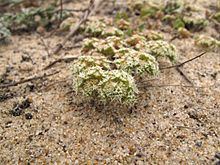Rank Species | Genus Chorizanthe Higher classification Chorizanthe | |
 | ||
Similar Chorizanthe, Erysimum teretifolium, Chorizanthe robusta, Polygonaceae, Gilia tenuiflora | ||
Chorizanthe pungens is a species of flowering plant in the buckwheat family known by the common name Monterey spineflower. It is endemic to California, where it is known from the San Francisco Bay Area south along the Central Coast.
Contents
Description
It grows mainly in coastal habitat and that of the hills and mountains overlooking the coastline. This is a generally erect but sometimes spreading or prostrate plant with stems up to half a meter in length. It is green to gray to red in color and usually hairy in texture. The leaves are located at the base of the plant; there are also bracts along the stem at the bases of the inflorescences which look like leaves. The inflorescence is a dense cluster of flowers, each flower surrounded by six white to pink hairy bracts tipped in hooked awns. The flower itself is only a few millimeters wide with jagged tepals.
Varieties
There are two varieties of this species:
